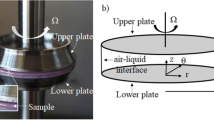Abstract
The hydrodynamic interaction between two particles suspended in shear flows is fundamental to the macroscopic characterization of suspension flows. Although such interaction in quiescent or linear shear flow is well understood, studies on that in a nonlinear shear field are rare. In this study, the hydrodynamic interaction between two neutrally-buoyant smooth spheres moving at negligible Reynolds numbers in an unbounded plane Poiseuille flow has been calculated by three-dimensional boundary element method (BEM) simulations. The BEM results have been compared with the analytical results obtained with the method-of-reflection (MoR) approximations. The BEM simulations have been found to provide satisfactory predictions if the number of elements on the spheres are more than 200, whereas the MoR approximations provide satisfactory predictions only when the minimum separation between the spheres is relatively large although this MoR method has the advantage to easily calculate the hydrodynamic interaction between two spheres freely moving at negligible Reynolds numbers in unbounded quadratic flow by solving ordinary differential equations. Furthermore, it is found that there is a preferential cross-streamline migration of the center-of-gravity of the sphere-pair in the plane of shear in plane Poiseuille flow which does not arise in simple shear flow. This migration is always directed towards low shear regions when the sphere having larger translational velocity approaches the other sphere, and reverses towards high shear regions when the faster sphere leads the other sphere in the plane of shear. There is also a cross-streamline migration of the center-of-gravity of the sphere-pair in the plane of vorticity, but this migration does not have a preferential direction. These migrations are symmetric about the point where the spheres are at the minimum separation, and are only significant when the hydrodynamic interaction of the spheres is strong. These results show that the migration of the center-of-gravity of the sphere-pair can be attributed to the nonlinearity of the shear field, which agrees with the MoR approximations. The hydrodynamic interaction between the two spheres has been quantified under various conditions by the BEM simulations for both identical and disparate spheres.
Similar content being viewed by others
References
Batchelor GK (1972) Sedimentation in a dilute suspension of spheres. J Fluid Mech 52:245–268
Batchelor GK, Green JT (1972) The hydrodynamic interaction of two small freely-moving spheres in a linear flow field. J Fluid Mech 56:375–400
Brenner H, O’Neill ME (1972) On the Stokes resistance of multiparticle system in a linear shear field. Chem Eng Sci 27:1421–1439
Haber S, Brenner H, Shapira M (1990) Diffusion, sedimentation and Taylor dispersion of a Brownian cluster subjected to a time periodic external force: a micromodel of AC electrophoretic phenomena. J Chem Phys 92:5569–5579
Cunha FR, Hinch EJ (1996) Shear-induced dispersion in a dilute suspension of rough spheres. J Fluid Mech 309:211–223
Stimson M, Jeffery GB (1926) The motion of two spheres in a viscous fluid. Proc R Soc London A111:110–116
Lin CJ, Lee KJ, Sather NF (1970) Slow motion of two spheres in a shear field. J Fluid Mech 43:35–47
Nir A, Acrivos A (1973) On the creeping motion of two arbitrary-sized touching spheres in a linear shear field. J Fluid Mech 59:209–223
Jeffrey DJ, Onishi Y (1984) Calculations of the resistance and mobility functions for two unequal rigid spheres in low-Reynolds-number flow. J Fluid Mech 139:261–290
Jeffrey DJ (1992) The calculation of the low Reynolds number resistance functions for two unequal spheres. Phys Fluids 4:16–29
Haber S, Brenner H (1999) Hydrodynamic interaction of spherical particles in quadratic Stokes flows. Int J Multiphase Flow 25:1009–32
Brady JF (1988) Stokesian dynamics. Ann Rev Fluid Mech 20:111–157
Bossis G, Brady JF (1987) Self-diffusion of Brownian particles in concentrated suspensions under shear. J Chem Phys 87:5437–5448
Chang C, Powell RL (1994) Self-diffusion of bimodal suspensions of hydrodynamically interacting spherical particles in shearing flow. J Fluid Mech 281:51–80
Nott PR, Brady JF (1994) Pressure-driven flow of suspensions: simulation and theory. J Fluid Mech 275:157–199
Foss DR, Brady JF (1999) Self-diffusion in sheared suspensions by dynamic simulation. J Fluid Mech 401:243–274
Marchioro M, Acrivos A (2001) Shear-induced particle diffusivities from numerical simulations. J Fluid Mech 443:101–128
Brebbia CA, Telles JCF, Wrobel LC (1984) Boundary Element Techniques. Springer, Berlin
Ingber MS (1989) Numerical simulation of the hydrodynamic interaction between a sedimenting particle and a neutrally buoyant particle. Int J Num Meth Fluids 9:263–273
Tran-Cong T, Phan-Thien N (1989) Stokes problems of multiparticle systems: A numerical method for arbitrary flow. Phys Fluids 1:453–461
Kim S, Karrila SJ (1991) Microhydrodynamics: principles and Selected Applications. Butterworth-Heinemann, New York
Dingman SE (1992) Three-dimensional simulation of fluid-particle interactions using the Boundary Element Method. PhD Thesis, The University of New Mexico
Hassonjee Q, Ganatos P, Pfeffer R (1988) A strong-interaction theory for the motion of arbitrary three-dimensional clusters of spherical particles at low Reynolds number. J Fluid Mech 197:1–37
Hassonjee Q, Pfeffer R, Ganatos P (1992) Behavior of multiple spheres in shear and Poiseuille flow fields at low Reynolds number. Int J Multiphase Flow 18:353–370
Mammoli AA, Ingber MS (2000) Parallel multipole BEM simulation of two-dimensional suspension flows. Eng Anal Bound Elem 24:65–73
Author information
Authors and Affiliations
Corresponding author
Rights and permissions
About this article
Cite this article
Lin, W., Graham, A.L., Ingber, M.S. et al. Hydrodynamic interaction of two neutrally-buoyant smooth spheres suspended in plane Poiseuille flow: the BEM simulations versus the MoR approximations. Comput Mech 36, 307–319 (2005). https://doi.org/10.1007/s00466-005-0668-3
Received:
Accepted:
Published:
Issue Date:
DOI: https://doi.org/10.1007/s00466-005-0668-3



